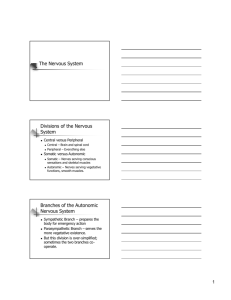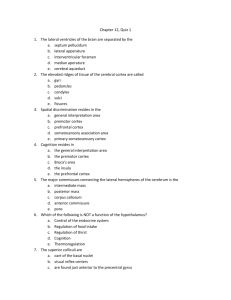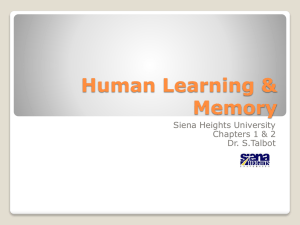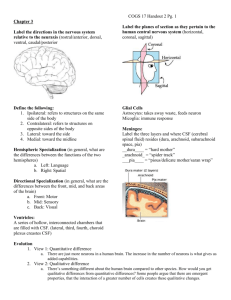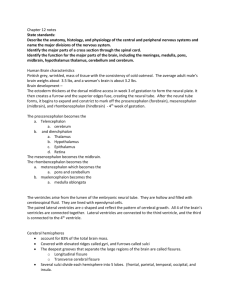THE NERVOUS SYSTEM
advertisement
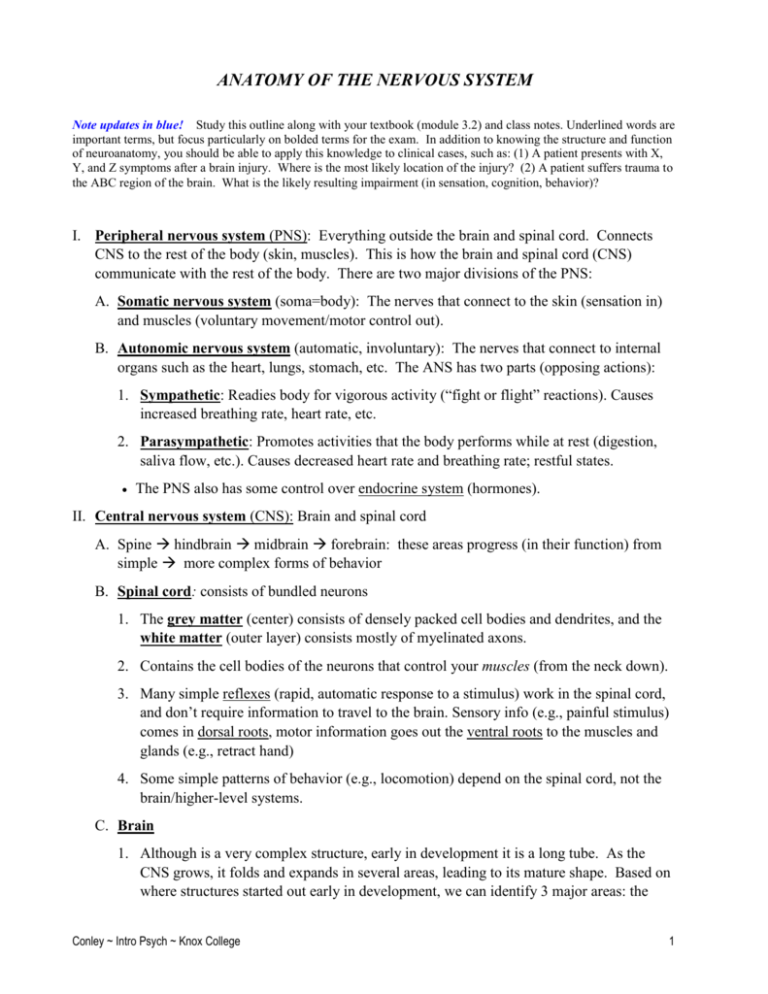
ANATOMY OF THE NERVOUS SYSTEM Note updates in blue! Study this outline along with your textbook (module 3.2) and class notes. Underlined words are important terms, but focus particularly on bolded terms for the exam. In addition to knowing the structure and function of neuroanatomy, you should be able to apply this knowledge to clinical cases, such as: (1) A patient presents with X, Y, and Z symptoms after a brain injury. Where is the most likely location of the injury? (2) A patient suffers trauma to the ABC region of the brain. What is the likely resulting impairment (in sensation, cognition, behavior)? I. Peripheral nervous system (PNS): Everything outside the brain and spinal cord. Connects CNS to the rest of the body (skin, muscles). This is how the brain and spinal cord (CNS) communicate with the rest of the body. There are two major divisions of the PNS: A. Somatic nervous system (soma=body): The nerves that connect to the skin (sensation in) and muscles (voluntary movement/motor control out). B. Autonomic nervous system (automatic, involuntary): The nerves that connect to internal organs such as the heart, lungs, stomach, etc. The ANS has two parts (opposing actions): 1. Sympathetic: Readies body for vigorous activity (“fight or flight” reactions). Causes increased breathing rate, heart rate, etc. 2. Parasympathetic: Promotes activities that the body performs while at rest (digestion, saliva flow, etc.). Causes decreased heart rate and breathing rate; restful states. The PNS also has some control over endocrine system (hormones). II. Central nervous system (CNS): Brain and spinal cord A. Spine hindbrain midbrain forebrain: these areas progress (in their function) from simple more complex forms of behavior B. Spinal cord: consists of bundled neurons 1. The grey matter (center) consists of densely packed cell bodies and dendrites, and the white matter (outer layer) consists mostly of myelinated axons. 2. Contains the cell bodies of the neurons that control your muscles (from the neck down). 3. Many simple reflexes (rapid, automatic response to a stimulus) work in the spinal cord, and don’t require information to travel to the brain. Sensory info (e.g., painful stimulus) comes in dorsal roots, motor information goes out the ventral roots to the muscles and glands (e.g., retract hand) 4. Some simple patterns of behavior (e.g., locomotion) depend on the spinal cord, not the brain/higher-level systems. C. Brain 1. Although is a very complex structure, early in development it is a long tube. As the CNS grows, it folds and expands in several areas, leading to its mature shape. Based on where structures started out early in development, we can identify 3 major areas: the Conley ~ Intro Psych ~ Knox College 1 hindbrain (back, last part before spinal cord), the midbrain (middle) and the forebrain (the front of the tube). 2. Hindbrain (a) Pons and Medulla: just above spinal cord; sometimes considered an extension of the spinal cord. Note that the brain stem = spinal cord, pons, medulla. (i) important in controlling muscles and sensory information of the head and face (e.g., chewing, swallowing). (ii) The medulla in particular is important in controlling vital reflexes, including breathing, heartrate, vomiting, salivation, coughing, and sneezing. Damage to this area is thus often fatal. (Sidebar: Opiates suppress activity of the medulla, which is why overdoses can be fatal.) (iii)The pons is where neurons from the left side of the body and spinal cord cross over to the right side of the brain (and vice versa). (iv) The reticular formation is also part of this area, and it has important functions in sleep and arousal; damage can make a person persistently alert or persistently drowsy. (b) Cerebellum: Important in producing smooth movements, and in learning to make smooth motor behavior. Important in any behavior that requires aim, timing, rhythm, judging visual-temporal info (speed, delay), or responding with precise timing. 3. Midbrain (middle of the brain) contains these parts and functions: (a) Superior colliculus: orienting, eye movements, bringing stimulus into visual field (b) Inferior colliculus: hearing (c) Substantia niagra: connected to dopamine; involved in Parkinson’s (deterioration of these neurons) 4. Forebrain (most anterior, most prominent, most advanced functions) (a) Thalamus: at the center/core of the brain; important for sensory relay – most sensory info (except for olfaction, which goes straight to cerebral cortex) goes first to the thalamus, which processes it, then sends it on to the cerebral cortex; controls what information (e.g., reflex info from the spinal cord) gets up to the cerebral cortex (b) Limbic System: interlinked structures deep in the brain that are important for motivations and emotions such as eating, drinking, sexual activity. Includes: (i) Hypothalamus: important in basic life life-sustaining drives/behaviors: hunger (foraging, looking for food, feeding), thirst (drinking), reproductive behavior (sexual activity), temperature regulation, fighting, activity level, etc.; Also related to the endocrine system (conveys messages to the pituitary gland, which alters its release of hormones into the bloodstream). (ii) Hippocampus and Amygdala (see temporal lobe, below) Conley ~ Intro Psych ~ Knox College 2 (iii)Several other structures, such as the cingulate gyrus and olfactory bulb also are in the limbic system 5. The brain has two hemispheres (left and right), connected by the corpus callosum, a bundle of neurons crossing over from one hemisphere to the other (to facilitate communication between the hemispheres). (a) A severed corpus callosum 2 hemispheres cannot communicate. Each hemisphere is responsible for sensation (input) and motor control (output) primarily on the opposite side. Because the left hemisphere produces speech (in most people), patients with a severed corpus callosum usually cannot say a word they see in their left visual field (because this information goes to their right lobe, which usually cannot produce speech). However, these patients can point to the object that the word represents, with their left hand (controlled by the right hemisphere). See details on pages 88-90. 6. Cerebral cortex: the outer surface of the brain, mostly made up of cell bodies and dendrites (gray matter), which travel deeper into the brain through axons (forming the inner white matter) (a) Some interesting history: In the early 1800s Joseph Gall popularized the idea of phrenology, that different brain areas are responsible for our character and personality traits, such as “stinginess” and “hope” and “impatience” and that we could read the bumps (enlarged areas) on one’s head to learn how stingy or hopeful or impatient the person was. Now we know that there is some specialization in the brain (different regions have different functions), but it’s not as specific as his theory (and personality traits can’t be mapped onto one discrete brain region). (b) The cerebral cortex is organized into 4 lobes, described below: 7. The 4 lobes of the brain and cortex are symmetrical, split over the two hemispheres. (a) Occipital lobe: vision (i) Much of the occipital lobe, which contains the primary visual cortex, is devoted to vision. Damage in the occipital lobe can leave us blind, or can remove our ability to see colors, or to see movement. Interestingly, cortical blindness (due to severe damage in this region) can leave a person unable to imagine visual information or to have visual dreams. (ii) Damage to the occipitotemporal region can result in a condition called prosopagnosia: unable to recognize faces (b) Parietal lobe: body sensations, visual-spatial attention (i) Contains the primary somatosensory cortex, which has the neurons that respond to touch in specific body regions (see map p. 81). (ii) Other parts of the parietal lobe help relate visual information to spatial information [understand spatial info/positioning; perception of body’s location in space]. Damage can result in difficulty locating objects in space, confusing two objects. Conley ~ Intro Psych ~ Knox College 3 (iii) Damage to the right parietal lobe can result in a condition known as (Hemi)neglect: These patients ignore the left side of their world (eating food, shaving, dressing, placing numbers on a clock, bisecting a line in half, etc.) (c) Temporal lobe: auditory processing and many other functions. (i) Auditory processing: hearing, understanding spoken language, producing speech, complex hearing (e.g., recognizing melodies and other complex sounds) (ii) Language comprehension: Wernicke’s area (in the left temporal lobe) damage/aphasia difficulty understanding speech, remembering names of objects; own speech hard to understand. Aphasia: the loss of a previously held ability to speak or understand spoken or written language, due to disease or injury of the brain. Another type is: Language production: Broca’s area (in the left frontal lobe, bordering temporal) damage/aphasia inarticulate speech, difficulties using and understanding grammatical devices. (iii)Complex visual processing: perceiving/recognizing faces, complex patterns, and visual movement (iv) Emotional/motivational behaviors: the deep temporal lobes include two important structures from the limbic system (see above): The amygdala is important in many aspects of emotion (facial expressions that convey emotion; connecting stimuli to emotions--e.g. rattle of a snake to fear). Damage to the amygdala can lead to a rare condition known as Capgras' delusion: loved ones are imposters The hippocampus is important in memory (critical for storing certain kinds of new memories). Damage impairs storing new memories, but not retrieval of old memories (think of Memento; also the true case of “HM”). (d) Frontal lobe: movement, planning, reasoning, decision-making, working memory (i) Primary motor cortex: The frontal lobe contains the part of the cortex that controls our ability to make (fine) voluntary/planned movements. Each part of the PMC controls a different part of the body (usually on the opposite side of the body, though there is slight control over the same side of the body). (ii) Prefrontal cortex: working memory, organization and planning movements, etc. Receives information from the various sensory systems the PFC integrates this information. People with prefrontal damage (e.g., Phineas Gage & “Elliot,” see p. 461): lose social inhibitions, ignoring the rules of polite, civilized conduct. They often act impulsively because they fail to calculate adequately the probable outcomes of their behaviors Note: Much of this information is taken from Introduction to Psychology and Biological Psychology, both by James W. Kalat. Conley ~ Intro Psych ~ Knox College 4

